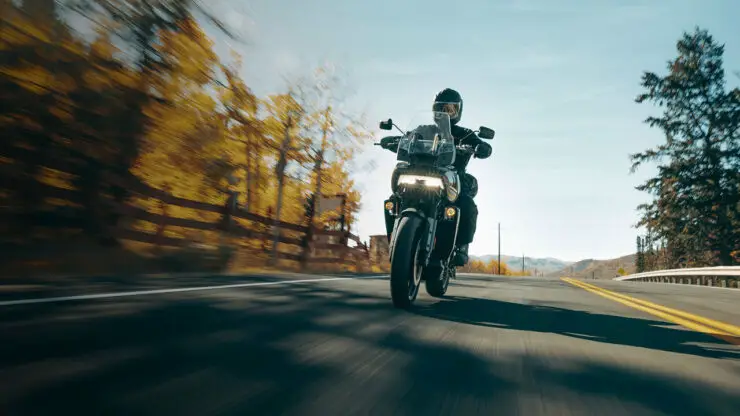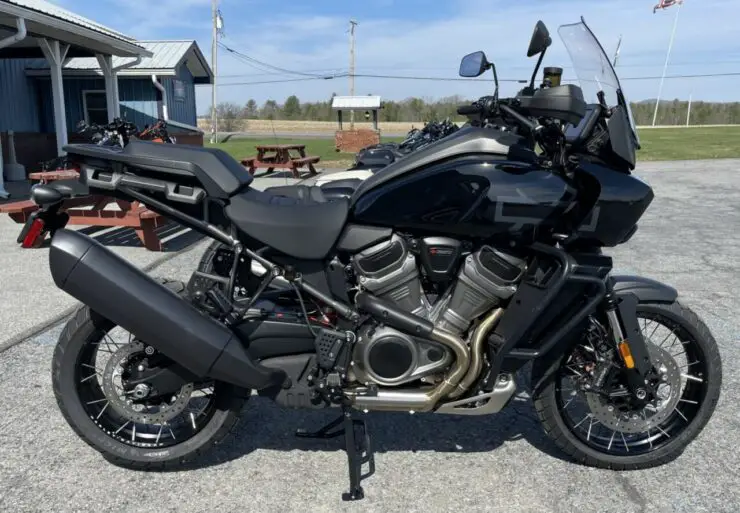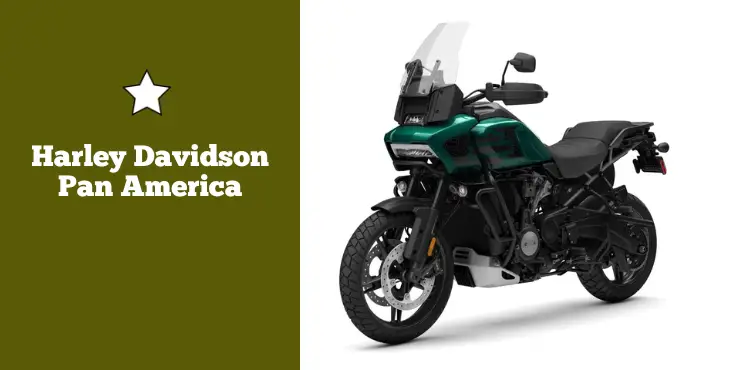Get ready to rev your engines and hit the open road, because Harley-Davidson is back with an exciting new addition to their lineup. Introducing the highly anticipated Harley-Davidson Pan America 1250, set to be released in 2023. With a rich history of crafting powerful and iconic motorcycles, Harley-Davidson has once again managed to create something truly exceptional. In this article, we will dive into the design, performance, comfort, features, ride experience, maintenance, and more, to give you a comprehensive overview of what the Harley-Davidson Pan America 1250 has to offer. So buckle up, because this is one ride you won’t want to miss.
Harley-Davidson Pan America 1250 (2023) – An adventure tourer unlike any other
A few years ago, Harley-Davidson made a bold gambit with the introduction of the Harley-Davidson Pan America. After all, USA’s stalwart heavy V-twin cruiser company, the 800-pound gorilla in the OEM room entered the adventure world, a realm that was already dominated by capable machines from numerous manufacturers.
The introduction of the Pan America series speaks volumes to Harley’s innovative forays into the market, something that the brand doesn’t get enough credit for. To take a risky corporate gamble in a highly competitive segment, with a risk of alienating a devoted customer base was rather impressive. The company deserves kudos for how cleverly it has managed its established persona as a tried-and-tested American legend over the years, while at the same time also testing new waters.
The Pan America line debuted in 2021 virtually and Theo Keetell, the VP Marketing of Harley-Davidson had this to say upon the bike’s launch –
“We’re thrilled to bring the world together virtually to showcase the inspiration and passion behind our 2021 motorcycles, including a glimpse of our first adventure touring motorcycle, Pan America. We look forward to sharing this moment with our customers and dealers from around the world.”

2023 Harley-Davidson Pan America 1250 Review
The Pan American lineup has enjoyed impressive success over the years. The 2023 model introduces refinements to the Pan America package, ensuring the bike’s place on the adventure touring mantel as a true contender. With that said, a Harley-Davidson Pan America 1250 (2023) review will go a great way in helping you become better versed with the bike.
Seat quality and position
As stock seats go, Harley-Davidson is especially friendly to boney butts. To be sure, the comfort attributed to a motorcycle seat is a personal affair. What is one gluteus maximus’ LA-Z-Boy recliner will be another’s plank of nails. The 2023 Pan America 1250, however, stands out for being rather flat and well-padded.
The seating position is rather peachy as well. Aftermarket suppliers have made a killing by supplying bar risers to bike manufacturers. Ostensibly, adventure tourers’ handlebars are designed in a way for a compromise between street riding and off-road riding. This means there will be a compromise involved that puts the bar in a place appropriate for standing on the pegs while jumping logs. Meanwhile, adventure bikes venture off-road as seldom as SUVs do. Almost all models from every BMW, Suzuki, or KTM need a riser to get the handgrips in the right position to enjoy comfortable touring.
Not the Harley-Davidson Pan America 1250 (2023). You can just loosen the top clamp, rotate the stock bar around 15 degrees, and boom! You will be able to enjoy 1,000 kilometres of back-affirming, shoulder-coddling comfort. You will be able to get the best riding position for your bike. There will be nothing stiff or sore.
Motor and engine
Milwaukee’s 1,252cc Revolution Max 60-degree V-twin has managed to gain widespread and well-deserved praise. Thanks to variable valve timing, it’ll have a plot of torque in the midrange yet it’ll explode with vigor once you twist the throttle past 6,000 RPM. It isn’t as fast as KTM’s 1290 Adventure or Ducati’s V4-powered Multistrada, and most certainly will not hold a candle to the new 1290 that the Austrian company is looking to spring upon the market shortly. However, it is more than lusty enough for the majority, if not virtually at all, adventure riders. Unlike the brand’s Big Twin cruisers, it is incredibly responsive and impressively smooth at red line. With an optional Screamin’ Eagle muffler, it will howl when you go hard on the gas.
And going hard on the gas is what this motorcycle likes. You will be able to spin it and enjoy 133 rear-wheel horsepower, which is a creditable amount considering that Harley-Davidson claims around 150 horsepower at the crankshaft. More notably, it will do so at 9,300 RPM. Yes, it is 300 RPM past the red line. In fact, the power will still be increasing once the rev limiter cuts in.
The boisterousness can be tampered down, as there are multiple “modes” that can alter the power and throttle response. Sport, hardly surprisingly, will have the Revolution Max engine jumping off at the slightest twitch of the wrist and power at its maximum. Road maintains maximum power but still tames the mid-range response down a bit. Meanwhile, Rain mode, no surprise, dramatically tempers the throttle, softening the bottom-end response so that there is no unwanted and sphincter-puckering and slewing of the rear wheel. With these features, Harley-Davidson has been taking safety seriously.
You will be able to set custom modes. It will be an easy walk through the obvious submenus, allowing you to set traction control and power levels to your desire. More interesting will be that you’re able to choose between ABS modes. The Harley-Davidson Pan America 1250 (2023) will allow you to set the throttle response separately from power. As an experienced rider, my favorite here ended up being to have max power set at Sport, coupling it with “+1” throttle response. It is an impressive engine, especially for a company that is relatively new to this segment.
In fact, the Pan America’s engine has two foibles. The first one is that the throttle response could be a bit fluffy right off idle, especially before the engine fully goes up to the operating temperature. Despite its prodigious torque, it is still very easy to stall, the air-fuel mixture feeling lean at throttle tip-in. The other one is that the valvetrain clatters quite a bit, considering it is a high-tech double-overhead-cam VVT-ed affair. When starting the bike, the cacophony can sound like a Big Twin’s thrashing. Even if it does quieten down when the oil is fully warm, the valvetrain will never be as silent as competitors.
There is a great reason for that, namely that the Revolution Max V-twin is the only recent DOHC motorcycle engine that makes use of hydraulic valve adjusters. Noisy as they may be, anything that eliminates the toil and troubles of valve adjustment – adjusting the valves isn’t that difficult but getting off the bodywork to allow access to them will certainly be. It will be more than worth a little valve clatter.
| Model Name | Pan America™ 1250 |
| Year | 2023 |
| Engine Size | 1252 cc (76.4 ci) |
| Engine Type | Revolution® Max V Twin |
| Horsepower | 150 bhp @ 9000 RPM |
| Torque | 127 Nm @ 6750 RPM |
| Dry Weight | 505 lbs (229 kg) |
| Wet Weight | 540 lbs (245 kg) |
| Length | 89.4 in (2270 mm) |
| Wheelbase | 62.2 in (1580 mm) |
| Ground Clearance | 8.3 in (210.8 mm) |
| Fuel Capacity | 5.6 gallons (21.2 liters) |
| Fuel Efficiency | 46 US MPG (5.1 L/100km) |
| Seat Height | Not provided |
| Price | MSRP: $17,699 |
| Cooling | Liquid |
| Valve Configuration | DOHC |
| Compression Ratio | 13:1 |
| Starter | Electric |
| Fuel Type | Gas |
| Fuel Requirements | Regular |
| Fuel Injector | Yes |
| Transmission Type | Manual |
| Number Of Speeds | 6 |
| Primary Drive (Rear Wheel) | Chain |
| Front Suspension Type | Inverted Fork |
| Rear Suspension Type | Twin Sided Swing Arm |
| Front Brake Type | Dual Hydraulic Disc |
| Rear Brake Type | Hydraulic Disc |
| Anti-Lock Brakes | Standard |
| Seat Type | Two-Piece |
| Number Of Seats | 2 |
Suspension
Like all top-flight adventure motorcycles, the Pan America 1250 (2023) has computer-controlled, fully automatic suspension front and rear. Both compression and rebound damping will be adjustable and is spring preload. Basically, the Pan America’s forks and rear shock can be easily set up for any riding conditions and loading.
They’re controlled by the same modes – Sport, Road, and Rain, as the engine and two customizable settings allow the owner to mix and match the selections and parameters. There is a decided stiffness to the Sport setting, featuring the firmness damping whereas “Road” and “Rain” ease up on the damping. In almost all circumstances, the rear shock’s damping is perfect as both compression and rebound damping are well-controlled over a wide variety of speeds and roads.
The front fork can occasionally suffer from over-aggressive compression damping, which is common to all electrically adjustable motorcycle suspensions. Basically, these variable systems are based on keeping springing and the hard bits are relatively mild and make up the difference in ride quality between modes by adjusting compression damping. In Sport mode, it means the fork, whose damper, unlike the “linked” monoshock will travel at the same speed as the wheel can lock up over severe bumps. It won’t be any worse than similar arrangements on other top-flight adventure tourers but it still remains that the front suspension isn’t as buttery smooth as the rear.
The biggest improvement that Milwaukee’s engineers were able to build into the bike’s computerized suspension is great rider control. Currently, the suspension ride height can be controlled automatically with the sensors returning the spring and forks to the desired position irrespective of the loading.
This is a boon for touring riders. However, KTM recently upped the ante by equipping the automatic preload adjustment with a rider-controlled override. You’ll be able to either let the computer set the ride height or you can do so manually. However, even when you’re doing so manually, the actual adjustment will still be done through the infotainment screen. The rider will have to choose the preload setting and decide that the preload must be set anywhere between 10% and 90% of maximum, overriding whatever the computer feels is the best. For those who like their bike “bum up” for quicker steering, this feature is a Godsend and something that other Harley-Davidson bikes should emulate.
The “ARH” feature stands for Adaptive Ride Height. Like a camel sinking to its knees, allowing the short legs to climb abroad, Harley-Davidson’s Pan America lowers both of its rear monoshock and front fork so that the short of inseam can place feet firmly and confidently on the tarmac at a stop. Once riding, the suspension will return to its normal height and offer a comprehensive 190 millimeters of travel both front and rear.
As a solution to the growing issue of high seat heights among adventure touring bikes, Harley-Davidson’s solution is ingenious and frankly overdue. Sufficiently so that Triumph and Ducati have already started copying it and other motorcycle marques are sure to follow. It happens automatically and save for a flashing yellow light in the instrument panel, the rider will not have to do anything extra for ARH to perform its magic.

Does the 2023 Harley-Davidson Pan America 1250 have any quirks?
ARH’s issue is that, with the suspension lowered, employing the sidestand will be a bit of an issue. Designed for the standard, non-lowering suspension, it’ll turn out to be a bit too long for the ARH-equipped models. If you’re a lightweight and riding without luggage, you won’t notice much of a difference.
Say that you want to load the big aluminum sidecases and the topcase to the gunwales and go on a long round trip. If you want to deploy the sidestand, it will jam into the tarmac before it can fully extend. Your only choice would be to lean the motorcycle way over to the right such that it can swing to its fully open position or bounce up/down on the suspension. This is because once the system is shut down completely, the dampers pump up to their operational height, allowing the sidestand to deploy.
You need to remember to retract the sidestand before you start the engine as once you’ve turned on the key, the suspension will lower itself down again and you won’t be able to retract the damned stand unless you’re leaning the motorcycle way over to the right again. It isn’t elegant and it shouldn’t ideally have been fixed already.
Another issue is the windshield. The windscreen in Pan America 1250 (2023) is both adjustable and aerodynamically sound. Toggled easily between lower and higher positioning, it can fit a wide range of riders. Moreover, it is also turbulence-free, making it one of the better windscreens when it comes to minimizing helmet buffeting.
Unfortunately, the mounting is a bit flimsy, and, at speed, the screen tends to vibrate quite a bit. It isn’t too bothersome and will not affect comfort but considering it is in your eyesight constantly, it can be annoying. As someone who has dealt with bikes a lot, I feel that nothing more than a more rigid mounting plate will be needed to fix this issue.

